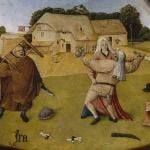I first read Alexandre Dumas’ The Count of Monte Cristo about fifteen years ago, in the unabridged edition from Oxford University Press. Recently Amazon had this same edition on sale as a Kindle book for $2.99 or something of the sort, and I grabbed it. Then it sat; and then, eventually, it became my backup book. Not the main book I was reading, but the one that I read from when I was between other, more gripping books. Because however much you like Dumas, he is seldom fast-paced for long—and The Count of Monte Cristo is a very long book.
I suppose everyone knows the gist of the story. Edmond Dantes, a young sailor with a bright future ahead of him, is falsely accused of being a supporter of the deposed emperor, Napoleon Bonaparte, and is confined to the Chateau d’If for over ten years. While in prison he becomes friends with another political prisoner, an aged priest, from whom he learns much about history, culture, and science. In time the priest dies, and Dantes escapes…and retrieves his friend’s fortune, which his friend has left to him. And now, with learning and money it’s time to track down the three men who put him in prison, and commit justice upon them.
That’s the set-up, and it’s the part I chiefly remembered. It’s all fairly straightforward, and frequently harrowing, and while interesting it’s all a real downer.
The part I didn’t remember—the part I fear I didn’t read very carefully or follow all that well—is the part that comes after Dantes escapes. I didn’t enjoy it that much fifteen years ago, because I wanted to follow Dantes’ story…and in the remainder of the book, Dantes, though the prime mover of everything that happens, is usually not the viewpoint character.
And here is where the book really began to fascinate me this time through, and where it moved decidedly into the foreground. See, here’s the thing. In the time that Dantes is in prison, and the subsequent time that he takes to lay his plans, his adversaries have all made their fortunes, married, and had children…and those children are now grown up and preparing to marry themselves. Dantes’ plans must encompass not only the parents but the children. And because of the way of the world, to achieve his aims Dantes must exploit the social networks of the day, the networks of friendship and kinship and elite status. And so indeed, the second part of the book is as much about them as it is about him, and their presence confounds his desire for vengeance.
Fascinating, and amazing, and well-worth your time. (And get the Oxford University Press World’s Classics edition.)















